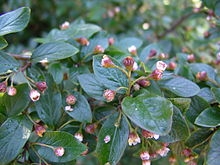
Alliaria petiolata, or garlic mustard, is a biennial flowering plant in the mustard family (Brassicaceae). It is native to Europe, western and central Asia, north-western Africa, Morocco, Iberia and the British Isles, north to northern Scandinavia, and east to northern Pakistan and Xinjiang in western China.
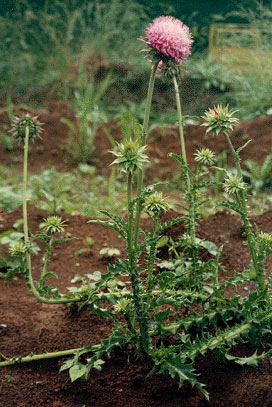
Carduus nutans, with the common names musk thistle, nodding thistle, and nodding plumeless thistle, is a biennial plant in the daisy and sunflower family Asteraceae. It is native to regions of Eurasia.

Rubus phoenicolasius is an Asian species of raspberry in the rose family, native to China, Japan, and Korea.

Polygonum arenastrum, commonly known as equal-leaved knotgrass, is a summer annual flowering plant in the knotweed family Polygonaceae. Other common names include common knotweed, prostrate knotweed, mat grass, oval-leaf knotweed, stone grass, wiregrass, and door weed, as well as many others. It is native to Europe and can be found on other continents as an introduced species and a common noxious weed. Knotweed was first seen in North America in 1809 and is now seen across much of the United States and Canada.

Lepidium virginicum, also known as least pepperwort or Virginia pepperweed, is an herbaceous plant in the mustard family (Brassicaceae). It is native to much of North America, including most of the United States and Mexico and southern regions of Canada, as well as most of Central America. It can be found elsewhere as an introduced species.
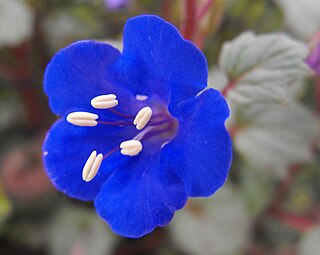
Phacelia campanularia is a species of flowering plant in the borage family, Boraginaceae, known by the common names desertbells, desert bluebells, California-bluebell, desert scorpionweed, and desert Canterbury bells. Its true native range is within the borders of California, in the Mojave and Sonoran Deserts, but it is commonly cultivated as an ornamental plant and it can be found growing elsewhere as an introduced species.

Poa trivialis, is a perennial plant regarded in the US as an ornamental plant. It is part of the grass family.
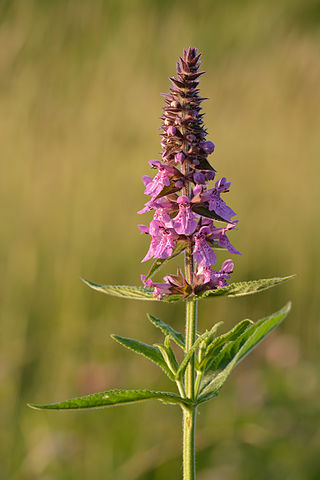
Stachys palustris, commonly known as marsh woundwort, clown's woundwort, clown's heal-all, marsh hedgenettle, or hedge-nettle, is an edible perennial grassland herb growing to 80 centimeters tall. It is native to parts of Eurasia but has been introduced to North America. The species epithet palustris is Latin for "of the marsh" and indicates its common habitat.
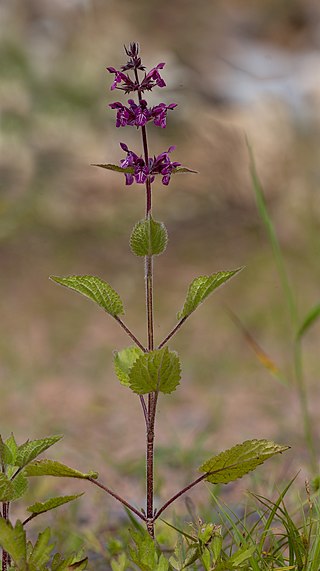
Stachys sylvatica, commonly known as hedge woundwort, whitespot, or sometimes as hedge nettle, is a perennial herbaceous plant growing to 80 cm (31 in) tall in woodland and unmanaged grassland. In temperate zones of the northern hemisphere it flowers in July and August. The flowers are purple. The leaves, when crushed or bruised, give off an unpleasant fetid smell.

Comarum palustre, known by the common names purple marshlocks, swamp cinquefoil and marsh cinquefoil, is a common waterside shrub. It has a circumboreal distribution, occurring throughout North America, Europe, and Asia, particularly the northern regions. It is most commonly found on lake shores, marshy riversides and stream margins, often partly submerged with foliage floating. It is a parent of some Fragaria–Comarum hybrids, ornamental plants produced by crossing with strawberries.

Verbascum blattaria, the moth mullein, is a flowering biennial plant belonging to the figwort family Scrophulariaceae. A native of Eurasia and North Africa, it has naturalized in the United States and most of Canada since its introduction and has become an invasive species there. It has been declared a noxious weed by the state of Colorado.

Spiraea japonica, the Japanese meadowsweet or Japanese spiraea, is a plant in the family Rosaceae.

Lappula squarrosa is a species of flowering plant in the borage family known by several common names, including European stickseed, bur forget-me-not, bluebur, and bristly sheepbur. It is native to Europe and Asia, where it is common, and it is an introduced species in much of North America and Africa. It is well known as a noxious weed where it is naturalized and also in many parts of its native range. This is an annual herb producing an erect stem often with sprays of many long, bending branches, its form varying in different regions and climates. The plant may approach a meter in height. The stems are lined with linear to oval leaves up to 5 centimeters long and coated in whitish hairs, and the herbage emits a scent generally considered unpleasant. The inflorescence is a long, leafy raceme of tiny flowers near the ends of the branches. Each flower is 2 to 4 millimeters wide with five light blue corolla lobes. White-flowered plants are occasionally seen. The fruit is a cluster of four nutlets which are coated in hooked prickles. The seeds are dispersed when the prickles get caught on animal coats and human clothing, and when they are moved by wind.
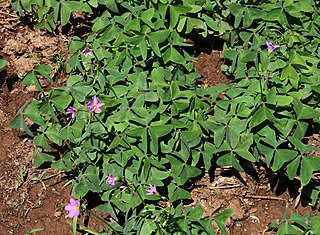
Oxalis latifolia is a species of flowering plant in the woodsorrel family known by the common names garden pink-sorrel and broadleaf woodsorrel. It is native to Mexico and parts of Central and South America.

Silene gallica is a species of flowering plant in the family Caryophyllaceae known by several common names, including common catchfly, small-flowered catchfly, and windmill pink. It is native to Eurasia and North Africa, but it can be found throughout much of the temperate world as a common roadside weed.

Stachys arvensis is a species of flowering plant in the mint family known by the common names field woundwort and staggerweed. It is native to Europe, Western Asia, and North Africa. It is known on other continents as an introduced species and widespread weed.

Tamarix chinensis is a species of tamarisk known by the common names five-stamen tamarisk and Chinese tamarisk or saltcedar. It is native to China and Korea, and it is known in many other parts of the world as an introduced species and sometimes an invasive noxious weed. It easily inhabits moist habitat with saline soils. It may grow as a tree with a single trunk or as a shrub with several spreading erect branches reaching 6 metres or more in maximum height. It has been known to reach 12 metres. It has reddish, brown, or black bark. The small, multibranched twigs are covered in small lance-shaped, scale-like leaves which are no more than about 3 mm long. The inflorescence is a dense raceme of flowers a few cm long. Each fragrant flower has five petals which are usually pink but range from white to red.

Crepis tectorum, commonly referred to as the narrowleaf hawksbeard or narrow-leaved hawk's-beard, is an annual or winter annual plant between 30 and 100 centimetres in height. Originating in Siberia before being introduced to Canada in 1890, the narrowleaf hawksbeard's is an invasive species. Maintaining one branched, hairless and leafy stem during maturity, the narrowleaf hawksbeard has yellow leaves which are arranged in an alternate manner and less than 0.5 inches (13 mm) wide.
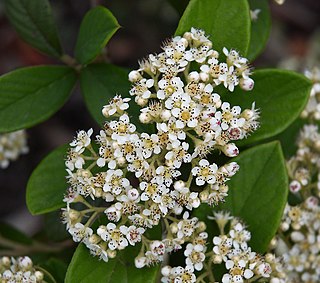
Cotoneaster lacteus, the late cotoneaster or milkflower cotoneaster, is a species of flowering plant in the genus Cotoneaster of the family Rosaceae, native to the Yunnan Province of China. It is a large evergreen shrub growing to 4 m (13 ft) tall and wide. Clusters of white flowers are followed by masses of small, globose, red fruits (pomes) in autumn. Unusually for this genus, the fruits are avoided by birds, hence garden escapes are rare, and the fruit persists on the plant throughout the winter.

Clinopodium menthifolium, commonly known as the wood calamint or woodland calamint, is a species of flowering plant in the mint family, Lamiaceae. It is found throughout southern and central Europe from the United Kingdom and east as far as temperate parts of Asia, and as south as North Africa. It grows up to 1,700 m (5,600 ft) in elevation.
